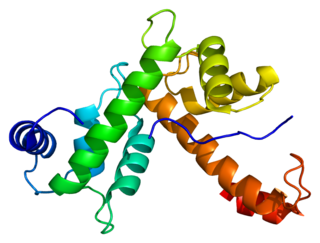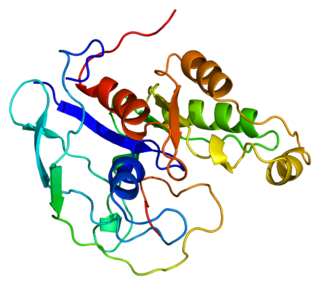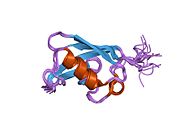
The activin A receptor also known as ACVR1C or ALK-7 is a protein that in humans is encoded by the ACVR1C gene. ACVR1C is a type I receptor for the TGFB family of signaling molecules.

60S ribosomal protein L5 is a protein that in humans is encoded by the RPL5 gene.

Programmed cell death protein 6 is a protein that in humans is encoded by the PDCD6 gene.

Casein kinase II subunit beta is a protein that in humans is encoded by the CSNK2B gene. It is a ubiquitous protein kinase which regulates metabolic pathways, signal transduction, transcription, translation, and replication. The enzyme localizes to the endoplasmic reticulum and the Golgi apparatus.

Proto-oncogene tyrosine-protein kinase Yes is a non-receptor tyrosine kinase that in humans is encoded by the YES1 gene.

Activated CDC42 kinase 1, also known as ACK1, is an enzyme that in humans is encoded by the TNK2 gene. TNK2 gene encodes a non-receptor tyrosine kinase, ACK1, that binds to multiple receptor tyrosine kinases e.g. EGFR, MERTK, AXL, HER2 and insulin receptor (IR). ACK1 also interacts with Cdc42Hs in its GTP-bound form and inhibits both the intrinsic and GTPase-activating protein (GAP)-stimulated GTPase activity of Cdc42Hs. This binding is mediated by a unique sequence of 47 amino acids C-terminal to an SH3 domain. The protein may be involved in a regulatory mechanism that sustains the GTP-bound active form of Cdc42Hs and which is directly linked to a tyrosine phosphorylation signal transduction pathway. Several alternatively spliced transcript variants have been identified from this gene, but the full-length nature of only two transcript variants has been determined.

Hematopoietic lineage cell-specific protein is a protein that in humans is encoded by the HCLS1 gene.

PITSLRE serine/threonine-protein kinase CDC2L1 is an enzyme that in humans is encoded by the CDK11B gene.

Autocrine motility factor receptor, isoform 2 is a protein that in humans is encoded by the AMFR gene.

RING-box protein 2 is a protein that in humans is encoded by the RNF7 gene.

Serine/threonine protein kinase NLK is an enzyme that in humans is encoded by the NLK gene. Its name is an abbreviation for Nemo-Like Kinase, Nemo (nmo) being the Drosophila ortholog of the mammalian NLK gene. This enzyme is a member of the Mitogen-activated protein kinase (MAPK) family, although not explicitly designated as such. It is a highly divergent, atypical member of the MAPK group, lacking most features so characteristic of most mitogen-activated protein kinases. Its activation mechanism and downstream targets are still not well characterized.

Ubiquitin/ISG15-conjugating enzyme E2 L6 is a protein that in humans is encoded by the UBE2L6 gene.

Cyclin-dependent kinase inhibitor 3 is an enzyme that in humans is encoded by the CDKN3 gene.

TSC22 domain family protein 1 is a protein that in humans is encoded by the TSC22D1 gene.

TNFAIP3-interacting protein 2 is a protein that in humans is encoded by the TNIP2 gene. TNIP2 contains multiple amino acid sites that are phosphorylated and ubiquitinated.

Serine/threonine-protein kinase PLK2 is an enzyme that in humans is encoded by the PLK2 gene.

MAP kinase-activated protein kinase 5 is an enzyme that in humans is encoded by the MAPKAPK5 gene. The protein encoded by this gene is a member of the serine/threonine kinase family. In response to cellular stress and proinflammatory cytokines, this kinase is activated through its phosphorylation by MAP kinases, including MAPK1/ERK, MAPK14/p38-alpha, and MAPK11/p38-beta. In vitro, this kinase phosphorylates heat shock protein HSP27 at its physiologically relevant sites. Two alternately-spliced transcript variants of this gene encoding distinct isoforms have been reported.

Myosin-XVIIIa is a protein that in humans is encoded by the MYO18A gene.

DNA polymerase delta subunit 4, also known as DNA polymerase delta subunit p12, is a protein that in humans is encoded by the POLD4 gene. It is a component of the DNA polymerase delta complex.

Fas associated factor family member 2 is a protein that in humans is encoded by the FAF2 gene.























